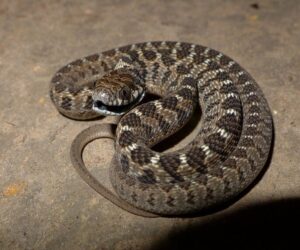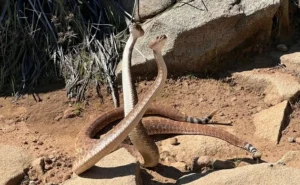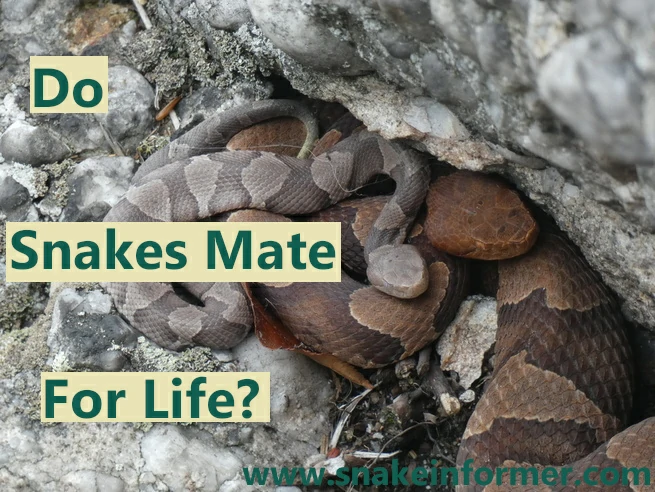Snakes are often seen as solitary creatures, slithering through the grass, and hidden among rocks. But what does this mean for their mating habits? Do snakes mate for life, or do they prefer to stay alone?
Snakes do not mate for life. They may form pairs during the mating season, but this is not based on long-term bonding, as seen in some birds or mammals. Once the breeding season is over, the males and females separate and continue to live solitary lives.
In the next mating season, snakes will form mating pairs with new individuals. There is no loyalty or ongoing connection between mates.
Snakes Are Solitary Creatures
Snakes are for the most part solitary animals. Unlike some birds and mammals that form long-term bonds, snakes are perfectly content to be alone.
They do not live in social groups or bunt together. They do best on their own.

This solitary nature is a weakness, instead, it’s a strong survival strategy.
By living alone, snakes reduce the chances of competing for scarce resources such as food, shelter, and basking places with other snakes.
In the wild, snakes often have loose territories where they do daily activities such as hunting, basking, or hiding under cover to avoid predators.
These areas are not defended, like some territorial animals, and snakes do not normally attack other snakes that wander into their territory.
Being solitary means snakes completely rely on their own skills to survive.
They don’t rely on a mate to find food or defend against danger.
Once a snake is born (hatches), it is on its own from day one and relies on its instinct to survive.
Snakes Form Pairs During the Mating Season
Although snakes are solitary animals, things change during the mating season. This is one of the few times they get social.
During the mating season (which is often in spring for most snake species), male snakes emerge out of hibernation (brumation) first and become very active.
Often they will travel great distances in search of females.
A few weeks later, the females emerge and emit pheromones to attract males.

Males, attracted by pheromones then track a potential mate with impressive accuracy.
In species (such as garter snakes), this can lead to many snakes gathering together.
If several males swarm a single female, a “mating ball” is formed – with males competing to push other males aside and get into the right position to mate.
After the female has mated, she stops emitting her pheromones and the males leave her alone, within a few minutes.
Once they have mated, the snakes go their separate ways immediately. They do not remain together to give birth to, or raise the babies. The female lays eggs or gives birth to live babies on her own.
Do Snakes Ever Reunite with the Same Mate?
Snakes have very simple brains and do not have the brain structures needed for remembering other snakes.
This means a snake is highly unlikely to recognize or even notice a previous mate if they happen to meet again.
They act on instinct, not on personal attachment or loyalty.
During the mating season, the male is only interested in finding any female to mate with.
If a male finds the same female again the next year, it is just a coincidence. There was no intention to go back to that female.
Interestingly, some female snakes have evolved a unique reproduction strategy that makes reunions even less necessary: sperm storage.
After mating, the female can keep the male’s sperm within her body for months or even years in some species.
This allows her to delay fertilization, and produce offspring at a time that is convenient to her biological or environmental requirements – without necessarily looking for a new partner.
Evolutionary Advantages of Changing Mates
For snakes, sticking to one partner has little benefit. By choosing new partners every season, snakes get several significant benefits that contribute to their survival and reproduction.
1. Increased Genetic Variation
Every new partner contributes a mix of genes to the gene pool. This genetic diversity is needed to form healthy populations.
Genetically different offspring are more likely to have beneficial traits, that help them survive diseases, harsh environmental conditions, or sudden changes in their surroundings.
2. Increased Rates of Offspring Survival
A genetically varied population of young snakes is more likely to thrive in an ever-shifting world.
For example, if a new predator or disease emerges, the offspring will inherit some traits that will enable them to survive (e.g., camouflage or quicker reflexes).
3. Increased Reproductive Success
Mating with multiple partners maximizes the chances of successful fertilization.
Males maximize their chances of passing their genes, while females gain access to the best available genetic material.
Females in some species carry sperm from several males and choose the strongest or the most compatible sperm to fertilize the eggs.
4. Adaptability Over Time
Changing mates each year allows populations of snakes an opportunity to evolve more quickly under changing circumstances.
The larger pool of traits among individuals accelerates evolution to deal with new dangers.
In short, mating for life is a good thing for some animals but not for snakes. They prefer flexibility, durability, and hereditary resistance through diversity. It’s about surviving.
Conclusion
Snakes are primarily solitary animals and do not mate for life. However, they show fascinating social behavior during the mating season.
These fascinating creatures remind us that nature often has different rules for different times and situations.
The next time you see a snake, remember that it values its independence.
Sources:
Walker, S. E., & Ford, N. B. (1996). Courtship and Mating Behavior in the Brown House Snake Lamprophis fulginosus. Journal of Herpetology, 30(3), 416–418. https://doi.org/10.2307/1565183
Rivas JA, Burghardt GM. Snake mating systems, behavior, and evolution: the revisionary implications of recent findings. J Comp Psychol. 2005 Nov;119(4):447-54. doi: 10.1037/0735-7036.
Levine BA, Schuett GW, Booth W. Exceptional long-term sperm storage by a female vertebrate. PLoS One. 2021 Jun 4;16(6):e0252049. doi: 10.1371/journal.pone.0252049.
Hi, my name is Ezra Mushala, i have been interested animals all my life. I am the main author and editor here at snakeinformer.com.

